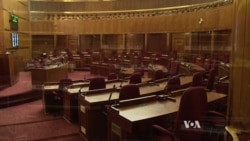North Dakota is one of four U.S. states with a legislature that meets only once every two years. But, the energy boom in Western North Dakota -- and everything that comes with it - is challenging the state government’s ability to respond rapidly to the changing environmental and economic landscape.
An abundance of jobs spurred by the extraction of oil in what's known as the "Bakken Formation" has fueled rapid population expansion in Williston, North Dakota, a town at the center of the oil boom.
That expansion has forced the state and local governments to play catch-up, including the Williston Public Schools.
Superintendent Viola LaFontaine says she’s dealing with a surge of new students on a budget outdated by at least a year.
“So if I get 300 more kids this year, I don’t get paid for them until the following year," she said. "There’s a year lapse when you get reimbursed for your students. So I have to come up with all the funding now to support my students I have in the system.”
One way to resolve this funding issue would be through the North Dakota State legislature, which meets in the state capital, Bismarck.
But most days throughout the year… this is the scene at the North Dakota state house: an empty chamber, and quiet hallways.
Lawmakers only meet once every two years, for an 80-day legislative session.
“There are a number of infrastructure issues that probably require more frequent addressing on a more frequent basis than every two years,” said Dean Bangsund, a scientist at North Dakota State University. He points out that as drilling technology changes, and more wells go into the ground, the state's oil development situation also changes.
“So every time the legislature meets, we have a new story to tell,” Bangsund said.
“Major issues that come up cannot be decided or worked on really for a final decision, other than during a legislative session,” Jay Buringrud, director of Legal Service for the North Dakota State Legislature.
Buringrud says the state gets around the gap in meetings by granting more authority to legislative committees and the state's governor.
“There are committees that are working on these issues on energy development, the impact of energy development and the governor is also working on issues that come up between legislative sessions,” he said.
Earlier this year, Democratic party lawmakers in the Republican-controlled legislature wanted to address some of those challenges. They urged Governor Jack Dalrymple to hold a special legislative session to address funding issues related to the oil boom. That request was rejected.
“If you look at it in its entirety, the state is responding, but many people would feel that the state hasn’t responded sufficiently,” Bangsund said.
Williston Superintendent Viola LaFontaine is one of those people.
“Maybe they need longer sessions than what they do," she said. "Some people say 'yeah they’d be better to meet every year.' I think just make better decisions on the two years you’re there! And help out western North Dakota.”
LaFontaine could wait until January of 2015 to get the help she seeks. That’s the next scheduled meeting of the North Dakota legislature.










